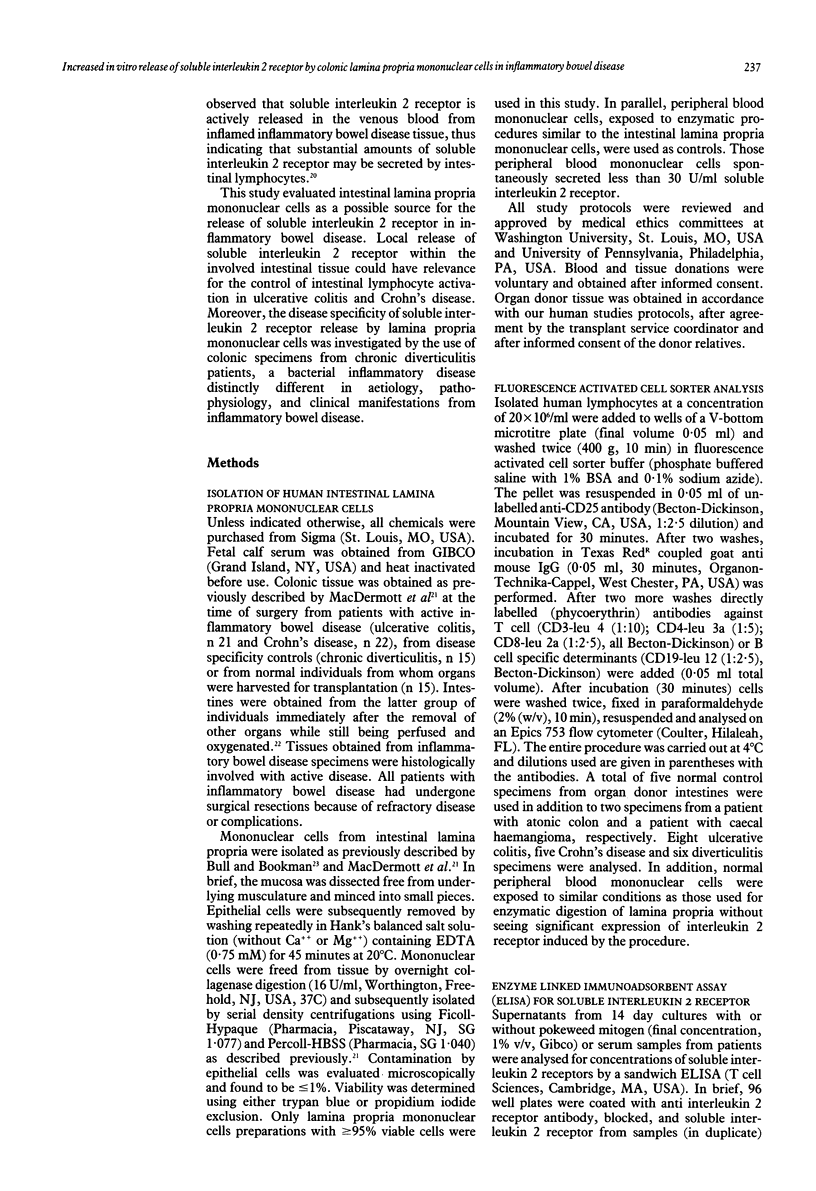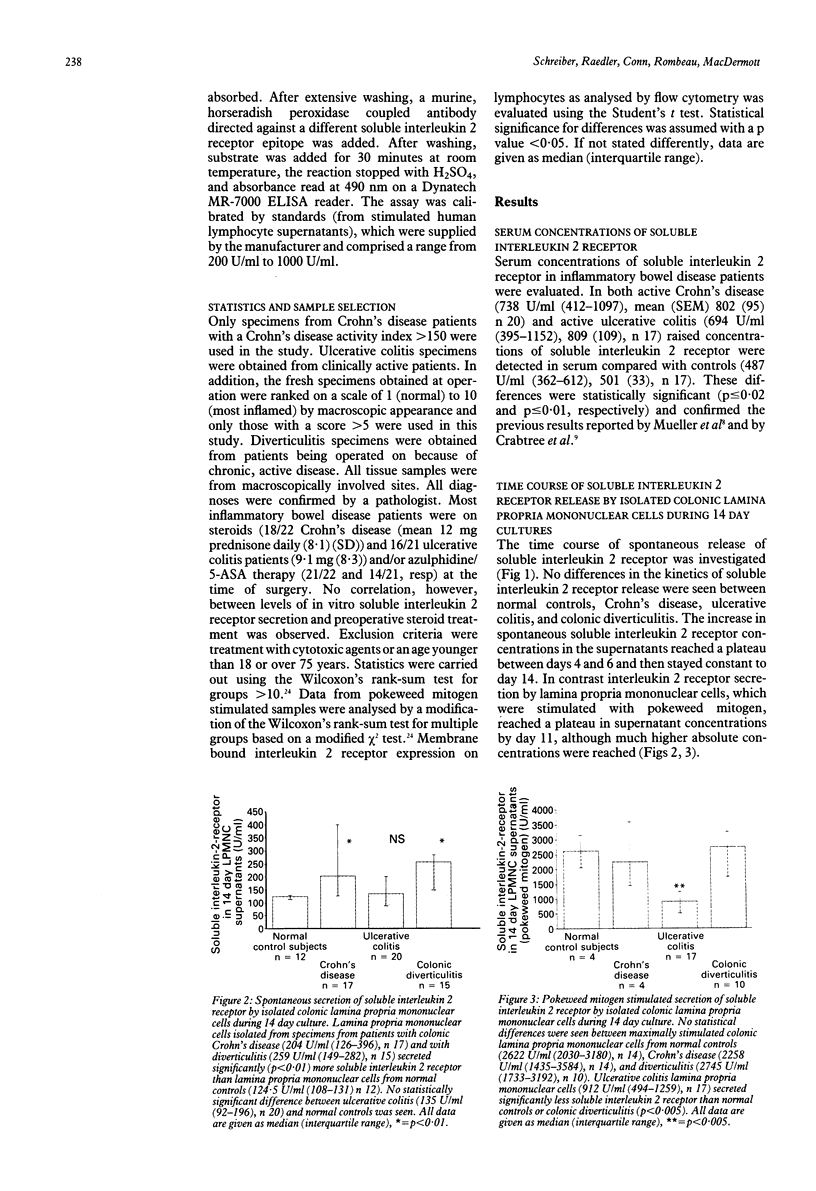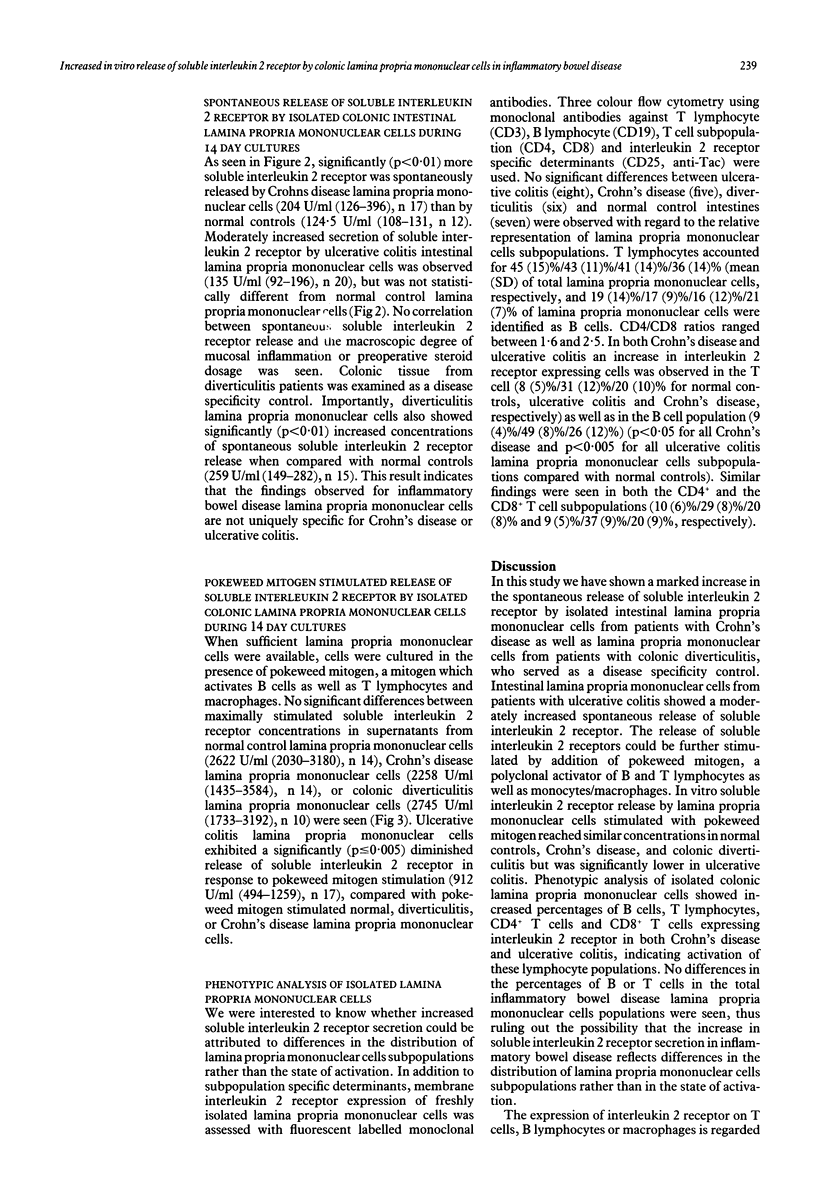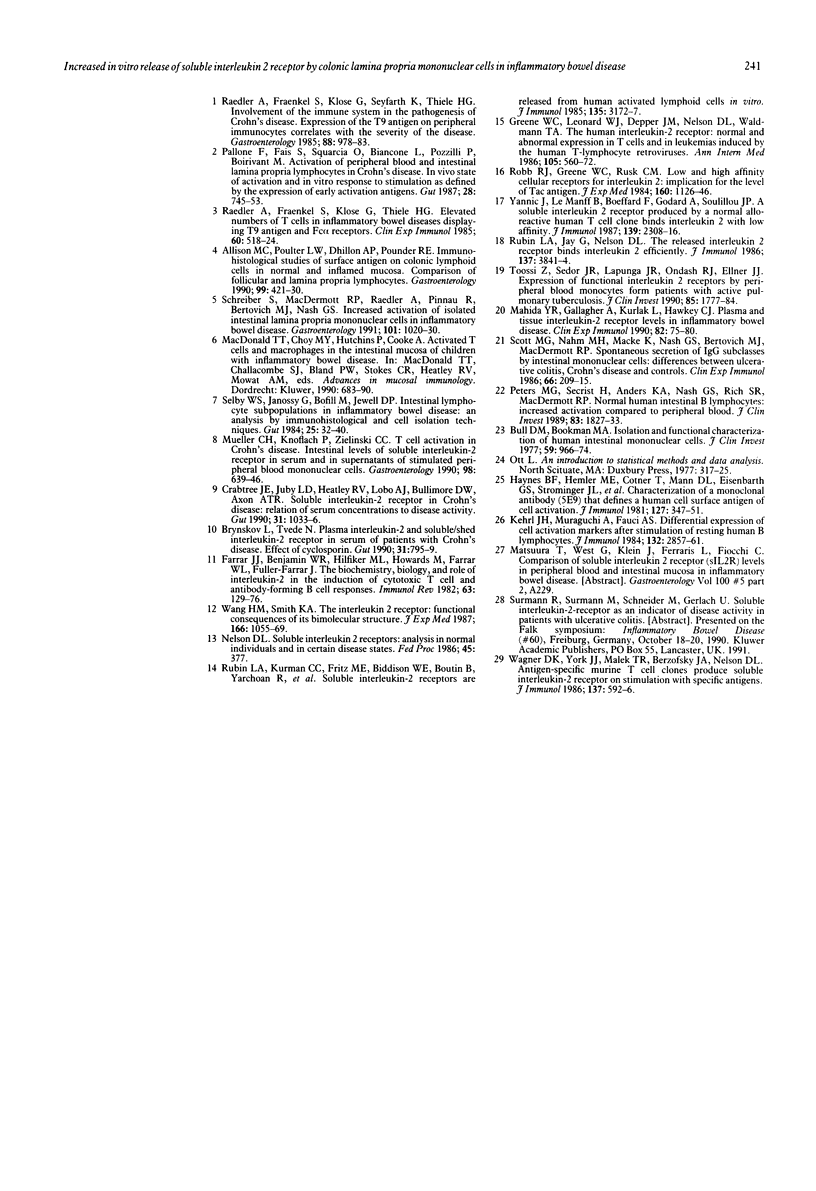Abstract
Increased concentrations of the soluble form of the interleukin 2 receptor have been observed in the sera of Crohn's disease and ulcerative colitis patients. In this study we have observed the spontaneous release of soluble interleukin 2 receptor by unstimulated, isolated normal and inflammatory bowel disease colonic lamina propria mononuclear cells. Lamina propria mononuclear cells from Crohn's disease patients (median = 204 U/ml (interquartile range 126-396, n 17) secreted significantly (p less than 0.01) more soluble interleukin 2 receptor than normal controls (median = 124.5 U/ml (108-131), n 12). No statistically significant differences were seen between ulcerative colitis (median = 135 U/ml (92-196), n 20) and normal controls. Moreover, significantly (p less than 0.01) increased amounts of soluble interleukin 2 receptor were secreted by colonic diverticulitis lamina propria mononuclear cells (median = 259 U/ml (149-282), n 15) which were used as disease specificity controls. Time course experiments showed that the majority of soluble interleukin 2 receptor was released by isolated lamina propria mononuclear cells in the first six days of culture. Upon stimulation with pokeweed mitogen, Crohn's disease (median = 2258 U/ml (1435-3584), n 14), normal control (median = 2622 U/ml (2030-3180), n 14) and diverticulitis lamina propria mononuclear cells (median = 2745 U/ml (1733-3192), n 10) reached similar maximal soluble interleukin 2 receptor secretion levels, while ulcerative colitis lamina propria mononuclear cells secreted significantly (p less than 0.005) less soluble interleukin 2 receptor (median = 912 U/ml (494-1259), n 17). These results suggest that enhanced shedding/secretion of soluble interleukin 2 receptor by intestinal lymphocytes may account in part for increased serum soluble interleukin 2 receptor concentrations during chronic intestinal inflammatory reactions.
Full text
PDF





Selected References
These references are in PubMed. This may not be the complete list of references from this article.
- Allison M. C., Poulter L. W., Dhillon A. P., Pounder R. E. Immunohistological studies of surface antigen on colonic lymphoid cells in normal and inflamed mucosa. Comparison of follicular and lamina propria lymphocytes. Gastroenterology. 1990 Aug;99(2):421–430. doi: 10.1016/0016-5085(90)91025-2. [DOI] [PubMed] [Google Scholar]
- Brynskov J., Tvede N. Plasma interleukin-2 and a soluble/shed interleukin-2 receptor in serum of patients with Crohn's disease. Effect of cyclosporin. Gut. 1990 Jul;31(7):795–799. doi: 10.1136/gut.31.7.795. [DOI] [PMC free article] [PubMed] [Google Scholar]
- Bull D. M., Bookman M. A. Isolation and functional characterization of human intestinal mucosal lymphoid cells. J Clin Invest. 1977 May;59(5):966–974. doi: 10.1172/JCI108719. [DOI] [PMC free article] [PubMed] [Google Scholar]
- Crabtree J. E., Juby L. D., Heatley R. V., Lobo A. J., Bullimore D. W., Axon A. T. Soluble interleukin-2 receptor in Crohn's disease: relation of serum concentrations to disease activity. Gut. 1990 Sep;31(9):1033–1036. doi: 10.1136/gut.31.9.1033. [DOI] [PMC free article] [PubMed] [Google Scholar]
- Farrar J. J., Benjamin W. R., Hilfiker M. L., Howard M., Farrar W. L., Fuller-Farrar J. The biochemistry, biology, and role of interleukin 2 in the induction of cytotoxic T cell and antibody-forming B cell responses. Immunol Rev. 1982;63:129–166. doi: 10.1111/j.1600-065x.1982.tb00414.x. [DOI] [PubMed] [Google Scholar]
- Greene W. C., Leonard W. J., Depper J. M., Nelson D. L., Waldmann T. A. The human interleukin-2 receptor: normal and abnormal expression in T cells and in leukemias induced by the human T-lymphotropic retroviruses. Ann Intern Med. 1986 Oct;105(4):560–572. doi: 10.7326/0003-4819-105-4-560. [DOI] [PubMed] [Google Scholar]
- Haynes B. F., Hemler M., Cotner T., Mann D. L., Eisenbarth G. S., Strominger J. L., Fauci A. S. Characterization of a monoclonal antibody (5E9) that defines a human cell surface antigen of cell activation. J Immunol. 1981 Jul;127(1):347–351. [PubMed] [Google Scholar]
- Jacques Y., Le Mauff B., Boeffard F., Godard A., Soulillou J. P. A soluble interleukin 2 receptor produced by a normal alloreactive human T cell clone binds interleukin 2 with low affinity. J Immunol. 1987 Oct 1;139(7):2308–2316. [PubMed] [Google Scholar]
- Kehrl J. H., Muraguchi A., Fauci A. S. Differential expression of cell activation markers after stimulation of resting human B lymphocytes. J Immunol. 1984 Jun;132(6):2857–2861. [PubMed] [Google Scholar]
- Mahida Y. R., Gallagher A., Kurlak L., Hawkey C. J. Plasma and tissue interleukin-2 receptor levels in inflammatory bowel disease. Clin Exp Immunol. 1990 Oct;82(1):75–80. doi: 10.1111/j.1365-2249.1990.tb05406.x. [DOI] [PMC free article] [PubMed] [Google Scholar]
- Mueller C., Knoflach P., Zielinski C. C. T-cell activation in Crohn's disease. Increased levels of soluble interleukin-2 receptor in serum and in supernatants of stimulated peripheral blood mononuclear cells. Gastroenterology. 1990 Mar;98(3):639–646. [PubMed] [Google Scholar]
- Pallone F., Fais S., Squarcia O., Biancone L., Pozzilli P., Boirivant M. Activation of peripheral blood and intestinal lamina propria lymphocytes in Crohn's disease. In vivo state of activation and in vitro response to stimulation as defined by the expression of early activation antigens. Gut. 1987 Jun;28(6):745–753. doi: 10.1136/gut.28.6.745. [DOI] [PMC free article] [PubMed] [Google Scholar]
- Peters M. G., Secrist H., Anders K. R., Nash G. S., Rich S. R., MacDermott R. P. Normal human intestinal B lymphocytes. Increased activation compared with peripheral blood. J Clin Invest. 1989 Jun;83(6):1827–1833. doi: 10.1172/JCI114088. [DOI] [PMC free article] [PubMed] [Google Scholar]
- Raedler A., Fraenkel S., Klose G., Seyfarth K., Thiele H. G. Involvement of the immune system in the pathogenesis of Crohn's disease. Expression of the T9 antigen on peripheral immunocytes correlates with the severity of the disease. Gastroenterology. 1985 Apr;88(4):978–983. doi: 10.1016/s0016-5085(85)80017-2. [DOI] [PubMed] [Google Scholar]
- Raedler A., Fraenkel S., Klose G., Thiele H. G. Elevated numbers of peripheral T cells in inflammatory bowel diseases displaying T9 antigen and Fc alpha receptors. Clin Exp Immunol. 1985 Jun;60(3):518–524. [PMC free article] [PubMed] [Google Scholar]
- Robb R. J., Greene W. C., Rusk C. M. Low and high affinity cellular receptors for interleukin 2. Implications for the level of Tac antigen. J Exp Med. 1984 Oct 1;160(4):1126–1146. doi: 10.1084/jem.160.4.1126. [DOI] [PMC free article] [PubMed] [Google Scholar]
- Rubin L. A., Jay G., Nelson D. L. The released interleukin 2 receptor binds interleukin 2 efficiently. J Immunol. 1986 Dec 15;137(12):3841–3844. [PubMed] [Google Scholar]
- Rubin L. A., Kurman C. C., Fritz M. E., Biddison W. E., Boutin B., Yarchoan R., Nelson D. L. Soluble interleukin 2 receptors are released from activated human lymphoid cells in vitro. J Immunol. 1985 Nov;135(5):3172–3177. [PubMed] [Google Scholar]
- Schreiber S., MacDermott R. P., Raedler A., Pinnau R., Bertovich M. J., Nash G. S. Increased activation of isolated intestinal lamina propria mononuclear cells in inflammatory bowel disease. Gastroenterology. 1991 Oct;101(4):1020–1030. doi: 10.1016/0016-5085(91)90729-5. [DOI] [PubMed] [Google Scholar]
- Scott M. G., Nahm M. H., Macke K., Nash G. S., Bertovich M. J., MacDermott R. P. Spontaneous secretion of IgG subclasses by intestinal mononuclear cells: differences between ulcerative colitis, Crohn's disease, and controls. Clin Exp Immunol. 1986 Oct;66(1):209–215. [PMC free article] [PubMed] [Google Scholar]
- Selby W. S., Janossy G., Bofill M., Jewell D. P. Intestinal lymphocyte subpopulations in inflammatory bowel disease: an analysis by immunohistological and cell isolation techniques. Gut. 1984 Jan;25(1):32–40. doi: 10.1136/gut.25.1.32. [DOI] [PMC free article] [PubMed] [Google Scholar]
- Toossi Z., Sedor J. R., Lapurga J. P., Ondash R. J., Ellner J. J. Expression of functional interleukin 2 receptors by peripheral blood monocytes from patients with active pulmonary tuberculosis. J Clin Invest. 1990 Jun;85(6):1777–1784. doi: 10.1172/JCI114635. [DOI] [PMC free article] [PubMed] [Google Scholar]
- Wagner D. K., York-Jolley J., Malek T. R., Berzofsky J. A., Nelson D. L. Antigen-specific murine T cell clones produce soluble interleukin 2 receptor on stimulation with specific antigens. J Immunol. 1986 Jul 15;137(2):592–596. [PubMed] [Google Scholar]
- Wang H. M., Smith K. A. The interleukin 2 receptor. Functional consequences of its bimolecular structure. J Exp Med. 1987 Oct 1;166(4):1055–1069. doi: 10.1084/jem.166.4.1055. [DOI] [PMC free article] [PubMed] [Google Scholar]


